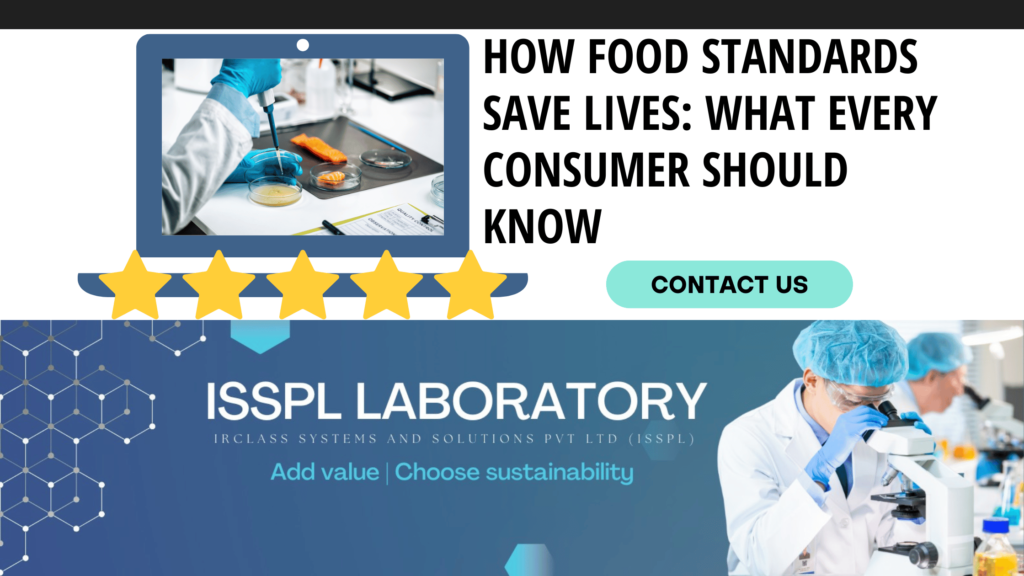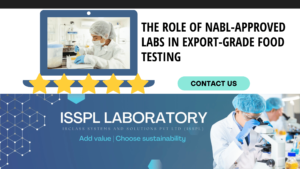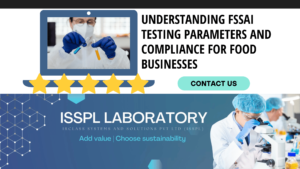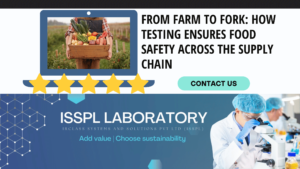An Overview by Team ISSPL - Analytical Testing Laboratory in India
ToggleMost people assume the food they eat is safe. That it’s been checked. That someone made sure it won’t make them sick. That’s not a coincidence. It’s the result of clear, strict food standards that exist to protect the public.
Food safety is not just a checklist. It’s a system. A structure that runs through farming, production, packaging, and sale. When that system works, people stay healthy. When it fails, lives are at risk.
Food standards save lives every day. But most consumers don’t think about it until something goes wrong. A stomach infection. A recall. A foodborne outbreak. These events are not rare. They happen in every country, in every city.
This is why standards are important. They are not optional. They are the difference between trust and risk. Between safety and illness.
Preventing foodborne illness
Food can carry bacteria, viruses, and toxins. It’s not always visible. It doesn’t always smell bad. You won’t always know before it’s too late.
Food standards set the minimum hygiene levels that must be maintained from the source to your plate. That includes farms, factories, kitchens, and even delivery systems.
Without standards, there would be no limit to how food is handled. Milk could be stored without refrigeration. Packaged food could be sold without expiry dates. That’s how outbreaks begin.
Standards make sure these things don’t happen. They prevent foodborne illness before it starts.As an example, food manufacturers must test against common pathogens such as E. coli, Listeria and Salmonella. In case they are detected, the batch should be destroyed. Compromises are not possible.
Ensuring safe and suitable food
It is not the only objective of safety. Food must also be edible. This implies that it must not contain physical, chemical and biological risks.
A food product should not cause harm to a person consuming it. That consists of additives, pesticide residues, heavy metals, and even the packaging material.
Food standards determine the limit of these substances. When the levels exceed the limit, the product will not be sold. This safeguards consumers against slow and long-term harm that they might not be aware of immediately.
All food items that are packaged are expected to be safe. The label should have ingredients. It should indicate whether it has allergens. In case the product is genetically modified, such information should be there.
This is not merely good practice. It is a requirement of Indian law.
Protecting vulnerable populations
Not everyone reacts the same way to contaminated food. Some people get mild symptoms. Others get hospitalized. In the worst cases, it leads to death.
Vulnerable groups include:
- Infants and young children
- Pregnant women
- Elderly individuals
- People with weakened immune systems
For them, even a small amount of contamination can be dangerous. That’s why food standards are designed to protect the weakest first. The safety levels are based on what’s safe for the most vulnerable. If it’s safe for them, it’s safe for everyone.
This is one reason food standards keep getting stricter. As more data becomes available, as more cases are reported, the rules change. The goal is to close the gap before harm happens.
Supporting sustainable development and trade
Food standards are not only a matter of safety. They are also regarding sustainability and fairness. In the international trade, food products should comply with the safety regulations of the importing country. Otherwise, the shipment is rejected. It will imply loss of money and credibility.
India is an exporter of various food products. Spices and tea to packaged snacks and ready to eat meals. They should all adhere to Indian and international standards. This involves hygiene, labeling, ingredient disclosure and shelf life.
Trade cannot be standardized. Nations cannot rely on what they are importing. It becomes simpler to commit fraud. Mislabeling increases. Prices are influenced.
Global trade is possible because of food standards. They assist small producers to access new markets. They safeguard the image of Indian products. And they promote equitable methods of food production, manufacture and distribution.
Addressing emerging risks
Food risks are not static. They change with time. New bacteria. New chemicals. Changes in farming methods. Longer supply chains. Cross-border contamination.
Food standards need to keep up. That’s why they are reviewed and updated regularly.
Today, food safety authorities look at:
- Antimicrobial resistance
- Genetically modified organisms
- Nanoparticles in packaging
- New allergens
- Unregulated supplements
As science progresses, so do the threats. Food standards are the first line of defense. They respond to new risks before they spread.
For example, the rise in processed food consumption has increased the need for better labeling. The rise in plant-based products has raised questions about fortification. All of these require new rules and clearer enforcement.

What consumers can do to ensure food safety
Regulators can only do so much. Food safety also depends on how consumers handle and prepare food. Once food is in the home, the responsibility shifts.
The basic principles are Clean, Separate, Cook, and Chill.
Clean
Wash your hands before and after handling food. Clean all surfaces, utensils, and produce. Dirty cutting boards and knives can spread bacteria.
Separate
Keep raw meat, seafood, and eggs away from ready-to-eat food. Use separate knives and boards for raw and cooked food. Don’t let juices from meat touch vegetables or fruit.
Cook
Use a thermometer. Cooking to the right temperature kills bacteria. Leftovers must be reheated to at least 165°F to be safe. Undercooked food is a common source of infection.
Chill
Refrigerate perishable food quickly. Thaw frozen food in the fridge, not at room temperature. Marinate in the fridge. Keep the refrigerator below 5°C and the freezer below -18°C.
Use safe water and raw materials
Boil the water if you are in doubt about its source. Be careful when buying from street vendors. Choose items that are sealed and labeled. Check the expiration dates. Do not buy puffed or leaking packaging.
These practices are not hard to follow. But they make a big difference. Food safety starts at home.
Regulatory authorities and consumer rights
In India, food regulation is handled by the Food Safety and Standards Authority of India (FSSAI). It sets rules. It issues licenses. It inspects facilities. And it responds to complaints.
Every packaged food product must have an FSSAI license number on the label. If it doesn’t, it’s illegal. That number can be used to track the manufacturer.
FSSAI also issues alerts, recalls, and public warnings. If there’s a serious issue, they can ban a product or shut down the company.
As a consumer, you have legal rights:
- The right to safe food
- The right to clear information through labeling
- The right to seek redressal if a product harms you
If you fall ill after eating something, and you suspect it’s due to that product, you can report it. Complaints can be filed on the FSSAI website or through the Food Safety Connect app.
You can also take legal action under the Consumer Protection Act. That includes compensation for harm, damage, or emotional distress.
Consumers are not powerless. You don’t have to accept unsafe food. You can demand better.
Conclusion
Food standards are not just guidelines. They are lifesaving rules. They prevent illness, protect the vulnerable, support trade, and respond to new risks. But they only work when everyone takes them seriously.
Consumers need to read labels. Follow safe practices. Report unsafe food. And understand their rights.
Regulators enforce the law. Companies must comply. But systems need to support all three.
IRCLASS Systems & Solutions Pvt. Ltd. (ISSPL) enables that support. Their solutions help businesses align with food safety standards, digitize their workflows, and train teams on what matters most – protecting lives through safer food.







